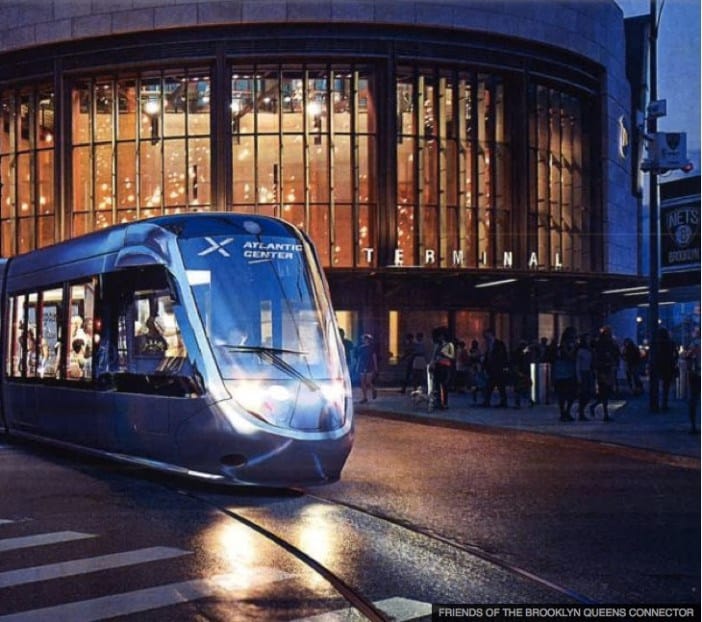Brooklyn-Queens Connector Streetcar May Become Reality Under Mayor’s $2.5 Billion Proposal


After stating last month that Mayor Bill de Blasio was taking the idea of a potential trolley streetcar between Brooklyn and Queens “under consideration,” representatives from his office and other city agencies are now confirming his formal support for the proposal, which was based off a study commissioned by a group called the Friends of the Brooklyn Queens Connector.
The New York Times reports that de Blasio plans to announce his push for a $2.5 billion Brooklyn-Queens Connector during today’s State of the City speech, and that the above-ground service would utilize existing rails on city streets along the East River, from “the industrial centers of Sunset Park, Brooklyn, to the upper reaches of Astoria, Queens.”
The price tag is also apparently “significantly less” than a new underground subway line would cost to connect the two boroughs, which have seen a population boom and growth in industry that has increased calls to create a direct transportation line that bypasses Manhattan.

The Times also invokes legendary — and often controversial — urban planner Robert Moses:
For Mr. de Blasio, a Democrat focused on social reform, the plan also represents a shift to the kind of ambitious Robert Moses-style planning that New Yorkers more often associate with his predecessor, former Mayor Michael R. Bloomberg, who made transportation a hallmark of his tenure.
The mayor’s support might come as less of a surprise when one considers the many prominent Brooklyn community leaders who are part of the Friends group.
Friends of the Brooklyn Queens Connector is made up of some heavyweight names, including Helena Durst of the Durst Organization real estate firm, Doug Steiner of Steiner Studios (located in the Brooklyn Navy Yard), and Fred Wilson of the venture capital firm Union Square Ventures.
Gothamist reports that it is not clear whether the Friends of the Brooklyn Queens Connector is the same group that commissioned the study. A search for the committee does not yield an official website.
Jill Eisenhard is the director of the Red Hook Initiative community group who is also a member of the Friends committee. She tells the Daily News that “too much of the city is underserved by our transit system, and we need to be looking at ideas like this to create a 21st century network.”
Construction on the rail line would not commence until at least 2019, with service not beginning until around 2024 at the earliest.
Alicia Glen, the deputy mayor for housing and economic development, acknowledged “some significant engineering challenges when you are putting a modern system like this in a very old city.”
But Ms. Glen said the city’s existing transit network no longer met the needs of a metropolis whose commuting patterns have shifted significantly in the last two decades. A streetcar route, she said in an interview, offered a novel and practical fix at a time when federal money for infrastructure is scarce.
“The old transportation system was a hub-and-spoke approach, where people went into Manhattan for work and came back out,” Ms. Glen said. “This is about mapping transit to the future of New York.”
. . . “The more mass transit we have, the better off we are as a city that is growing,” said Richard Ravitch, a former chairman of the Metropolitan Transportation Authority.
In his book, Mr. Ravitch said, the plan was “brilliant.” He added, “Not everybody’s going to ride bikes.”
Reporting contributed by Donny Levit.




